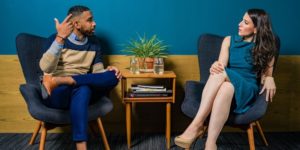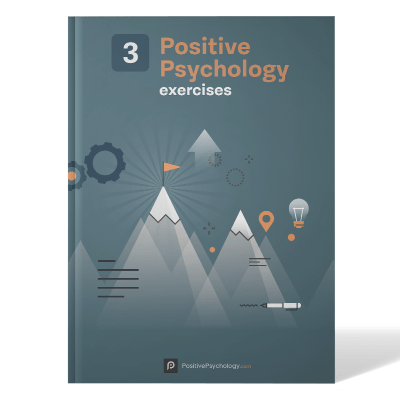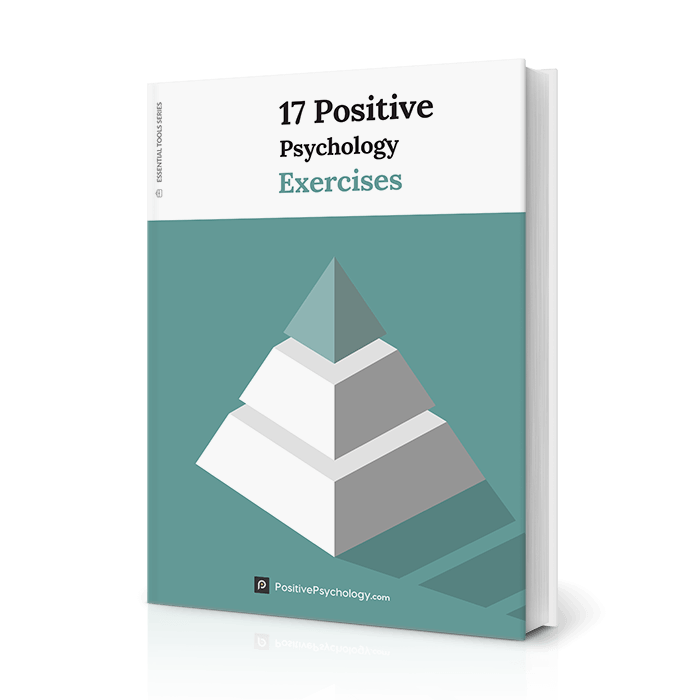12 Popular Counseling Approaches to Consider
 Looking for a counselor may feel like an overwhelming endeavor, especially for someone already dealing with troubling symptoms, trauma, or loss.
Looking for a counselor may feel like an overwhelming endeavor, especially for someone already dealing with troubling symptoms, trauma, or loss.
The myriad of counseling approaches, styles, and specialties are undoubtedly confusing.
With this article, we will guide you through more than 12 popular counseling approaches and consider specific challenges, disorders (e.g., trauma, depression, and anxiety), and client populations (e.g., couples and students).
By highlighting these important areas, we hope you will find yourself more informed and prepared to find the right type of counseling approach to contribute to a more balanced, peaceful, and contented life.
Before you continue, we thought you might like to download our three Positive Psychology Exercises for free. These science-based exercises will explore fundamental aspects of positive psychology including strengths, values, and self-compassion, and will give you the tools to enhance the wellbeing of your clients, students, or employees.
This Article Contains:
What Are Counseling Approaches?
A counselor’s approach is a reflection of their training and coaching philosophy.
For example, a therapist trained in behaviorism will view a client’s behavior as a function of reward and punishment systems. Behavioral counselors primarily focus on how behavior is impacted by environmental factors, as opposed to thoughts or unconscious motivations.
Counseling approaches and coaching styles also are differentiated by how therapists interact with clients. For example, client-centered counselors tend to focus on a client’s innate goodness and use a nondirective style of interaction.
Generally speaking, counseling approaches are guided by theory and research, both of which inform the method of practice.
12 Most Common Approaches
 With that said, we take a look at the most common approaches.
With that said, we take a look at the most common approaches.
Although there are many more, which you can find on our blog, we focus on this selection for a start.
1. Psychodynamic Counseling
Psychodynamic Counseling is probably the most well-known counseling approach.
Rooted in Freudian theory, this type of counseling involves building strong therapist–client alliances.
The goal is to aid clients in developing the psychological tools needed to deal with complicated feelings and situations. Freud also was concerned with the impact of early experiences and unconscious drives on behavior. This focus is evident in the following quote:
The conscious mind may be compared to a fountain playing in the sun and falling back into the great subterranean pool of subconscious from which it rises.
Sigmund Freud
Some of the ways in which these drives are uncovered include dream interpretation, projective tests, hypnotism, and free association.
Historically, Psychodynamic Therapy was a lengthy process, but nowadays, it is also applied as a relatively short-term approach. Research has indicated effectiveness for both long- and short-term psychodynamic treatment for psychiatric issues (Bögels, Wijts, Oort, & Sallaerts, 2014; Knekt et al., 2008; Leichsenring et al., 2009).
2. Interpersonal Counseling
Interpersonal Counseling is a diagnosis-focused approach in which the client’s disorder is regarded as a medical illness that requires intervention (Markowitz & Weissman, 2004).
In this sense, any fault or self-blame is diminished for the client. The role of interpersonal relationships and attachment on mental health outcomes is also an important target for this type of counseling.
It is a time-limited approach during which clients learn that their psychological issues are linked to environmental stressors. Interpersonal counselors are supportive and compassionate, serving as client allies.
Such therapists suggest ways for clients to deal with situations in a way that promotes self-efficacy and reduces symptoms (Markowitz & Weissman, 2004). Based on clinical trials, Interpersonal Therapy has been effective at treating psychiatric disorders, especially depression (Markowitz & Weissman, 2004).
3. Humanistic/Client-Centered Counseling
Humanistic Counseling is based on the assumption that individuals already possess the qualities needed to flourish. This approach encourages curiosity, intuition, creativity, humility, empathy, and altruism (Giorgi, 2005; Robbins, 2008).
Humanistic Counseling was first developed by Carl Rogers, who later founded Client-Centered Therapy, a Humanistic Counseling style that helps clients reach their full potential as human beings.
Client-Centered Therapy promotes a safe climate in which the therapist is empathetic and nonjudgmental. In this way, the client experiences a sense of acceptance, openness, and unconditional positive regard.
These ideas are beautifully articulated by Rogers, who noted that:
People are just as wonderful as sunsets if you let them be. When I look at a sunset, I don’t find myself saying, ‘Soften the orange a bit on the right-hand corner.’ I don’t try to control a sunset. I watch with awe as it unfolds.
Carl Rogers
Rogers’s words also convey the importance of allowing the client to make their own discoveries rather than providing a lot of therapist direction. Therefore, with a client-centered counselor, the client usually does most of the talking. The therapist’s role is to guide clients in an accepting way, helping them to see the beauty within themselves.
4. Existential Therapy
Existentialism is a philosophy aimed at examining the question of human existence. It is often associated with 19th and 20th-century writers and philosophers such as Jean-Paul Sartre, Soren Kierkegaard, Albert Camus, and Friedrich Nietzsche.
Existential thinking is also inherent in ancient Greek philosophy going as far back as Socrates from 469 to 399 BCE (Flynn, 2009).
Existential Therapy does not attempt to cure a person nor diminish specific symptoms; rather, it seeks to explore and question aspects of the human predicament (Corbett & Milton, 2011). The client is viewed as ever changing and always in the process of becoming (Dryden, 2007).
Existential therapists operate from the client’s perspective to explore what it means to be alive. They work with the client to examine unfulfilled needs and potential, and how to make rational choices. While this counseling approach is still evolving, research has indicated significant reductions in anxiety and depression symptoms following short-term Existential Therapy (Rayner & Vitali, 2015).
5. Cognitive-Behavioral Therapy
Cognitive-Behavioral Therapy (CBT) is grounded in the assumption that “emotional disorders are maintained by cognitive factors, and that psychological treatment leads to changes in these factors through cognitive and behavioral techniques” (Hofmann & Smits, 2008, p. 621).
In other words, by combining both cognitive and behavioral approaches, CBT focuses on how thoughts and behaviors dictate a person’s feelings in a given situation.
The following principles guide Cognitive-Behavioral Therapy:
- Mental health disorders involve key learning and information processing mechanisms.
- Behaviors are better understood by exposing their true functions.
- New adaptive learning experiences can be used to substitute prior maladaptive learning processes.
- Therapists use a scientific approach to therapy by creating hypotheses about patients’ cognitive and behavioral patterns, intervening and observing outcomes, and reframing original hypotheses as needed (Hazlett-Stevens & Craske, 2004).
A variety of different techniques and components may be included in CBT, such as exposure, social skills training, cognitive restructuring, problem-solving training, journaling, and relaxation training.
6. Mindfulness-Based Counseling
Mindfulness-Based Counseling is grounded in mindfulness philosophy, which “refers to a process that leads to a mental state characterized by nonjudgmental awareness of the present moment experience, including one’s sensations, thoughts, bodily states, consciousness, and the environment while encouraging openness, curiosity, and acceptance” (Hofmann, Sawyer, Witt, & Oh, 2010, p. 169).
During Mindfulness-Based Therapy, the client pays attention to their feelings and thoughts in the moment, without judgment. Following Buddhist traditions, it is an open minded and accepting way of responding to thoughts (Kabat-Zinn, 2005).
Mindfulness-Based Counseling is an increasingly popular approach aimed at helping clients to increase relaxation while removing negative or stressful judgments. This technique helps to teach clients how to deal with emotional stressors reflectively instead of reflexively (Hofmann et al., 2010).
Different types of mindfulness meditation approaches may be applied as part of Mindfulness Counseling, such as yoga, breathing meditation, sitting meditation, body scan, and sound scan.
Body scan involves gradually attending to different parts of the body while tensing and then relaxing muscles. With sound scan, responses to sounds are adjusted so that their aversive impact is reduced. While mindfulness approaches are often added into CBT and other forms of therapy, there is recent evidence supporting their unique benefit for reducing anxiety (Blanck et al., 2018).
Mindfulness is a state of mind that helps us cultivate a non-judgmental focus on the present moment. It encourages us to bring awareness to our body sensations, thoughts, and emotions.
Importantly, mindfulness is an important predictor of wellbeing and has been associated with greater levels of life satisfaction, positive affect, autonomy, and competence (Brown & Ryan, 2003).
Over the last decade, scientific research on mindfulness has strongly increased. We know that for some of us, mindfulness can be experienced naturally and with minimal training. Yet, we also know that mindfulness can also be trained in various ways.
Therefore, with the right tools, everyone has the capacity to bring a deeper sense of mindfulness to their lives.
Mindfulness X© is an 8-module mindfulness training package for practitioners which contains all the materials you’ll need to enhance your mindfulness skills and also learn how to deliver a science-based mindfulness training to clients, students, or employees.

7. Rational-Emotive Therapy
Albert Ellis developed Rational-Emotive Therapy in the mid-1900s. It is a type of CBT in which a person’s distress is perceived as a function of irrational or faulty thinking.
The therapist works with the client to examine their cognitive appraisals of how an event may have created an outcome (Gonzalez et al., 2004). In other words, it is the client’s belief about a situation, rather than the situation itself, that is the focus of treatment.
Unlike Client-Centered Therapy, Ellis’s Rational-Emotive approach is active and directive, intending to help clients avoid self-defeating beliefs and ultimately experience a more positive sense of wellbeing.
8. Reality Therapy
Reality Therapy was developed by William Glasser in the 1950s. Its principles stem from Alfred Adler’s ideas about the social context of human behavior (Wubbolding, 2010). It is based on choice theory, which focuses on the power of individuals to control their behaviors.
While not all aspects of life are within our power to change, human beings are always faced with opportunities to respond rationally or responsibly – or not (Peterson, 2000).
Reality Therapy helps clients to establish greater control over their lives while enhancing the ability to build meaningful and effective relationships. It is a present-day, non-symptom-focused approach in which the counselor takes on a friendly, positive, and nonjudgmental stance.
Reality Therapy promotes individual responsibility for actions while helping clients make decisions that are in line with the visions they have for their lives (Peterson, 2000; Wubbolding, 2010).
9. Constructionist Therapy
Constructionist Therapy is concerned with the meanings humans construct regarding the world around them. Within this framework, qualities believed to be related to gender, race, and social class are shaped by cultural influences and human interpretation (Sutherland & Strong, 2010). Constructionist Therapy is concerned with power imbalances and the importance of language (Munro, Knox, & Lowe, 2008).
More specifically, language is considered the avenue through which individuals create meaning about themselves and others. Language is viewed as constructive, involving various aspects of communication (e.g., questions, reflections, and interpretations), along with the invitation for “clients to develop specific constructions of their identities, problems, and relationships” (Sutherland & Strong, 2010, p. 257).
It is a client-driven process in which the client actively participates in discussions as to their problematic perceptions and constructions.
10. Systemic Therapy
Systemic Therapy underscores the influence of how patterns across systems (e.g., family, school, and employment) influence behaviors and psychological issues. A Systemic approach aims to treat the underlying system rather than focusing on the problem itself (Carlson & Lambie, 2012).
For example, Systemic Therapy is often used for family counseling, as it identifies dysfunctional patterns of communication and other behaviors across family members. Family involvement, which may be cross-generational, entails having family members work with the therapist to develop healthier roles, interactions, and dynamics.
11. Narrative Therapy
Narrative Therapy enables individuals to become experts in their own lives. Each of us has a story we tell ourselves about who we are as a person. Because we derive meaning from our stories, they shape and influence how we perceive and respond to the world around us.
By impacting our decisions, these narratives influence our ability to enjoy meaningful and satisfying experiences. Narrative counselors work collaboratively with clients to create alternate stories using a nonjudgmental, respectful approach (Morgan, 2000).
Ultimately, clients are guided in re-authoring their stories in a way that is more consistent with their life goals.
12. Creative Therapy
Creative Therapy involves the use of different art mediums aimed at improving mood and other aspects of wellbeing.
For example, Music Therapy consists of “the monitored use of music to promote clinical change” (Bulfone, Quattrin, Zanotti, Regattin, & Brusaferro, 2009, p. 238). Music Therapy may be used in multiple ways, such as in combination with CBT or other types of therapy.
Performing music may also foster positive feelings that reduce stress and promote healing. The scientific literature indeed supports a link between Music Therapy and reduced psychological symptoms such as anxiety (de l’Etoile, 2002; Bibb, Castle, & Newton, 2015; Shirani Bidabadi & Mehryar, 2015).
Art Therapy is also used as a creative therapeutic tool. Engaging clients in art projects such as healthy image posters, collages, and clay modeling provides a method of self-expression that goes beyond words.
Artistic expression also supports the cathartic release of positive feelings (Curl, 2008) and aids counselors in applying other types of therapy (Chambala, 2008). Research indicates that Art Therapy is indeed useful at reducing anxiety and other psychological symptoms across multiple populations (Chandraiah, Anand, & Avent, 2012; Sandmire, Gorham, Rankin, & Grimm, 2012).
Here are some of the key points that differentiate the counseling types we’ve mentioned so far:
| Counseling Type | Key Points |
|---|---|
| Psychodynamic | Focused on how past experiences affect current problems Concerned with unconscious drives and conflicting aspects of personality Traditionally, the therapist takes the expert role |
| Interpersonal Counseling | Diagnosis focused Concerned with interpersonal relationships Therapist functions as a client’s ally |
| Client-Centered Therapy | Humanistic approach Focused on realizing human potential Supports client discovery Counselor is empathetic, nonjudgmental, and nondirective |
| Existential Therapy | Focused on what it means to be alive Non-symptom focused Clients guided in discovering unfulfilled needs and realizing potential |
| Cognitive-Behavioral Therapy | Focused on how both thoughts and behaviors affect outcomes Evidence-based, effective, and highly versatile |
| Mindfulness-Based Counseling | Focused on feelings and thoughts in the moment, without judgment Includes CBT with a Buddhist-based mindfulness component Highly versatile |
| Rational Emotive Therapy | Focused on how faulty thinking relates to distress Therapist is active and directive |
| Reality Therapy | Focused on the present day Non-symptom focused Promotes individual responsibility and taking control of one’s life Counselor is positive and nonjudgmental |
| Constructionist Therapy | Focused on how cultural influences and interpretations shape meanings Strong interest in language Client driven, counselor acts as collaborator |
| Systemic Therapy | Focused on how systems (e.g., school, work, family) affect underlying issues Therapist collaborates with people across and within systems |
| Narrative Therapy | Focused on the stories we tell ourselves about who we are Counselor works collaboratively to create alternate stories |
| Creative Therapy | Focused on the use of artistic expression as a cathartic release of positive feelings Highly versatile — music and various art mediums may be used |
For Treating Depression and Anxiety
 Any of the above counseling approaches may be applied to treat anxiety and depression.
Any of the above counseling approaches may be applied to treat anxiety and depression.
The choice of therapy depends upon various other factors, such as the client’s specific symptoms, personality traits, coexisting diagnoses, family dynamics, a preferred way of interacting with the therapist, and treatment goals.
Depression
Several types of counseling are useful at treating depression, such as Behavioral Therapy, Cognitive-Behavioral Therapy, Interpersonal Therapy, and Mindfulness-Based Cognitive Therapy (Jorm, Allen, Morgan, & Purcell, 2013).
Behavioral Therapy for depression is a good fit for someone who needs help getting involved in activities and behaviors that are inconsistent with a depressed mood. The individual’s cognitions would not be the target of a behavioral intervention; rather, the client would be behaving their way out of depression.
On the other hand, a CBT approach would contain behavioral elements in addition to a focus on faulty beliefs and thought patterns contributing to depression. CBT is the most researched type of treatment for depression, with many studies supporting its efficacy (Jorm et al., 2013).
Mindfulness-Based CBT combines CBT with the element of present-moment awareness of how ruminative or wandering thoughts relate to depressed thinking (Jorm et al., 2013). Interpersonal Counseling involves working with the client to identify aspects of interpersonal relationships that contribute to depressive symptoms.
Overall, there are several effective approaches for treating depression, elements of which may be combined or modified to meet the client’s unique needs.
Anxiety
Anxiety treatment may also involve any of the above approaches; however, CBT is the most widely used approach for treating anxious symptomatology. CBT counselors working with anxious clients will tailor therapy to the individual needs of the client and make modifications based on their progress (Hazlett-Stevens & Craske, 2004).
CBT occurs in a variety of forms and may include different components.
Exposure Therapy is a type of CBT that is commonly used to treat anxiety disorders. This technique involves exposing the client to their feared object or situation. Such exposure is typically gradual, with the exposure beginning with less threatening stimuli and gradually working its way toward increasingly feared stimuli.
When systematic desensitization is used, gradual exposure also involves relaxation techniques as a way of pairing the feared stimulus with a state that is not compatible with anxiety.
Flooding exposure involves having a client confront their fears all at once (not gradually), based on the idea that without engaging in avoidance, the patient’s fear will be extinguished (Abramowitz, Deacon, & Whiteside, 2019).
Exposure Therapy also may include in vivo exposure (exposure to an actual feared object), simulated exposure (exposure to a proxy of a feared object), or virtual reality exposure (exposure to a highly realistic virtual space).
CBT comes in many forms, and it is generally regarded as a highly effective approach for treating anxiety (Butler, Chapman, Forman, & Beck, 2006; Deacon & Abramowitz, 2004).
Psychodynamic, Humanistic, Cognitive and Behavioral Therapy – Daniel Storage
Treating Trauma and Loss
All human beings experience loss of some sort; indeed, “suffering is part of the divine idea” (Beecher, n.d.).
Many of us also experience trauma, which is a deeply troubling and painful experience, such as involvement in a natural disaster, combat, personal violence, or the death of a child. Sometimes people can get through the various stages of grief and ultimately move forward with life after loss or trauma. But often, it becomes too much to bear without clinical help.
While many of the counseling approaches noted above are applicable, methods that are especially appropriate for treating trauma and loss are outlined below.
CBT is frequently used to treat loss, as well as trauma resulting in post-traumatic stress disorder (PTSD). For example, Prolonged Exposure Therapy was designed to treat PTSD.
With this approach, the therapist combines repeated in vivo and simulated exposure to enable the patient to experience trauma without the feared outcomes. This technique is considered by many clinicians as the best option for PTSD (Van Minnen, Harned, Zoellner, & Mills, 2012). Additionally, exposure that utilizes virtual reality headsets is also effective at treating PTSD (Powers & Emmelkamp, 2008).
Interpersonal Therapy is an additional option for those dealing with trauma and loss. Interpersonal Therapy examines symptoms related to loss through the lens of personal relationships.
Bereaved clients undergoing Interpersonal Therapy also may be guided in establishing new relationships (Wyman-Chick, 2012). Although often used to treat depression, research also has indicated that Interpersonal Therapy is a practical approach for PTSD (Rafaeli & Markowitz, 2011).
Another approach for treating loss, trauma, and PTSD is Eye Movement Desensitization and Reprocessing (EMDR). EMDR is based on the idea that psychological distress is the product of traumatic events that have been inappropriately processed.
The EMDR approach involves stimulating the brain’s information processing system while painful events are being recalled. Such stimulation may include eye movements, hand tapping, or listening to tones (Shapiro & Solomon, 2010). It is believed that the bilateral stimulation applied during EMDR enables the client to reprocess connections between memories and emotions.
Scientific research has indicated that the EMDR approach is valid for treating PTSD (Shapiro & Solomon, 2010).
Attending support groups is another approach that has the added benefit of creating a place in which clients are supported by those who can genuinely empathize with their feelings. Feelings of relatedness are often comforting for those who have felt isolated in their grief.
Support groups are not for everyone, as they do require the ability to interact with multiple people about painful life experiences. But for those who are ready and able to share in this way, they may enable participants to form deep bonds with others and benefit from multiple perspectives, as opposed to that of just one therapist.
Overall, these approaches only represent a few examples of counseling techniques designed to help people through stress, trauma, and loss. Various additional techniques are available (e.g., Spiritual Counseling, Hypnotherapy, Stress Inoculation Therapy, etc.) based on the client’s needs and preferences.
Approaches for Counseling Couples
 A couples counselor serves as an unbiased observer of the issues impacting a couple’s relationship.
A couples counselor serves as an unbiased observer of the issues impacting a couple’s relationship.
The counselor helps the clients to uncover underlying feelings such as mistrust, resentment, and pain. The couple will learn new ways of communicating and navigating areas in need of compromise.
There may also be situations in which a relationship is not salvageable (e.g., spousal abuse, serious substance use issues, etc.). In this case, the couples counselor may guide one or both clients toward the conclusion that the relationship is in such a state that counseling is not recommended.
Couples counselors work with several counseling tools and styles; for example:
- Drawing from Reality Therapy, the therapist might work with the couple regarding issues of power and control (Wubbolding, 2010).
- Interpersonal Counseling with couples emphasizes the role of relationships in affecting psychological outcomes. Systemic Therapy with couples aims to enhance connectedness and build stronger relationships (Johnson & Best, 2003).
- Narrative Counseling with couples guides clients toward improved relationships by acknowledging and adjusting their narratives (Besley, 2002).
- Existential Counseling with couples supports clients in experiencing more purposeful and meaningful lives.
- Finally, Client-Centered Counseling with couples guides clients in discovering the sources of their relationship issues.
Other couples counseling approaches not previously described include Holistic Counseling and the Gottman Method. With Holistic Counseling, couples therapists address a client’s full range of experiences and the entire being (e.g., mind, body, emotional, spiritual, and psychological).
The Gottman Method is a science-based couples therapy approach that enhances affection, respect, and admiration between couples. It takes place in three parts: the friendship system, the conflict management system, and the shared meaning system (Garanzini et al., 2017). The Gottman Method has been found to improve long-term relationship stability and satisfaction (Gottman & Gottman, 2008).
For Helping Students
 Reality Therapy has been used among school counselors and educators in numerous schools worldwide (Mason & Duba, 2009).
Reality Therapy has been used among school counselors and educators in numerous schools worldwide (Mason & Duba, 2009).
With an emphasis on personal responsibility, Reality Therapy techniques helps to empower students with the motivation to make decisions that are consistent with their goals (Mason & Duba, 2009).
Reality Therapy applies to a wide range of student levels and issues, including conduct problems among children and career development needs among college students.
Counselors use Reality Therapy by developing respectful and trustful bonds with students and serving as advocates to help them attain their goals and acquire a greater sense of self-esteem.
Effective educational applications of Reality Therapy have been reported for treating:
- Public speaking phobia (Harris, Kemmerling, & North, 2004)
- Identity crises (Kakia, 2010)
- Bullying behavior (Madukwe et al., 2016)
Reality Therapy has also been found to improve teacher happiness (Nematzadeh & Sary, 2014), which is yet another way of improving positive student outcomes.
Additional examples of counseling techniques for students include the following:
Motivational Enhancement Therapy
Motivational Enhancement Therapy is a brief approach designed to help school counselors enhance student motivation. It has been shown to promote academic achievement (Oluwole & Olanrewaju, 2016), reduce drinking-related outcomes (LaChance, Feldstein Ewing, Bryan, & Hutchison, 2009), and reduce problematic gambling behavior (Petry, Weinstock, Morasco, & Ledgerwood, 2009).
Systemic Family Therapy
Systemic Family Therapy is designed to improve student outcomes by addressing dynamics between individual, school, and family systems. It has been shown to reduce school refusal and anxiety (Schweitzer & Ochs, 2003), improve social and emotional learning (Oberle, Domitrovich, Meyers, & Weissberg, 2016), create safer school environments (Hernández & Seem, 2004), and promote family engagement in school (Davis & Lambie, 2005).
Cognitive-Behavioral Therapy
School counselors use CBT to work with students to identify the thought patterns and behaviors related to their presenting problems, treating student depression (Shirk, Kaplinski, & Gudmundsen, 2008), school refusal (Heyne et al., 2011), and behavior problems (Eyberg, Nelson, & Boggs, 2008), and improving students’ psychological wellbeing (Ruini, Belaise, Brombin, Caffo, & Fava, 2006).
A Take-Home Message
Those in search of a counselor have numerous research-supported options from which to choose. This article has described more than 12 such approaches, which vary in terms of underlying philosophical theories, treatment approaches, and counselor styles.
For example:
- Rational Emotive Therapy is a good choice if a client needs a directive therapist to help with irrational beliefs.
- Existential Therapy is a good option for dealing with a sense of meaningless and lack of purpose.
- CBT Exposure Therapy is an excellent choice for combatting phobias and PTSD.
Numerous counseling types are also available for individuals dealing with depression, anxiety, loss, or trauma (e.g., Interpersonal Counseling, CBT, and EMDR).
For couples, possible counseling choices include Holistic Counseling, the Gottman Method, Reality Therapy, and Narrative Therapy.
Finally, for students, there is a wide gamut of counseling possibilities that apply to everything from early behavioral problems to college-level achievement and substance use issues. Examples of counseling approaches for students include Reality Therapy, Systemic Family Therapy, CBT, and Motivational Enhancement Therapy.
The most crucial point to remember when choosing a counselor is that you find a provider who meets your unique needs, as a good therapist–client match is a crucial predictor of successful counseling outcomes (Bernier & Dozier, 2002).
We hope you enjoyed reading this article. Don’t forget to download our three Positive Psychology Exercises for free.
- Abramowitz, J., Deacon, B., & Whiteside, S. (2019). Exposure therapy for anxiety, second edition: Principles and practice. Guilford Press.
- Beecher, H. W. (n.d.) Retrieved March 11, 2020, from https://www.brainyquote.com/
- Bernier, A., & Dozier, M. (2002). The client-counselor match and the corrective emotional experience: Evidence from interpersonal and attachment research. Psychotherapy: Theory, Research, Practice, Training, 39, 32–43.
- Besley, A. C. (2002). Foucault and the turn to narrative therapy. British Journal of Guidance & Counselling, 30, 125–143.
- Bibb, J., Castle, D., & Newton, R. (2015). The role of music therapy in reducing post-meal related anxiety for patients with anorexia nervosa. Journal of Eating Disorders, 3, 50.
- Blanck, P., Perleth, S., Heidenreich, T., Kröger, P., Ditzen, B., Bents, H., & Mander, J. (2018). Effects of mindfulness exercises as stand-alone intervention on symptoms of anxiety and depression: Systematic review and meta-analysis. Behaviour Research and Therapy, 102, 25–35.
- Bögels, S. M., Wijts, P., Oort, F. J., & Sallaerts, S. J. M. (2014). Psychodynamic psychotherapy versus cognitive behavior therapy for social anxiety disorder: An efficacy and partial effectiveness trial. Depression and Anxiety, 31, 363–373.
- Brown, K. W., & Ryan, R. M. (2003). The benefits of being present: Mindfulness and its role in psychological well-being. Journal of Personality and Social Psychology, 84(4), 822-848.
- Bulfone, T., Quattrin, R., Zanotti, R., Regattin, L., & Brusaferro, S. (2009). Effectiveness of music therapy for anxiety reduction in women with breast cancer in chemotherapy treatment. Holistic Nursing Practice, 23, 238–242.
- Butler, A., Chapman, J., Forman, E., & Beck, A. (2006). The empirical status of cognitive-behavioral therapy: A review of meta-analyses. Clinical Psychology Review, 26, 17–31.
- Carlson, R., & Lambie, G. (2012). Systemic–developmental supervision. The Family Journal, 20, 29–36.
- Chambala, A. (2008). Anxiety and art therapy: Treatment in the public eye. Art Therapy, 25, 187–189.
- Chandraiah, S., Anand, S. A., & Avent, L. C. (2012). Efficacy of group art therapy on depressive symptoms in adult heterogeneous psychiatric outpatients. Art Therapy, 29, 80–86.
- Corbett, L., and Milton, M. (2011). Existential therapy: A useful approach to trauma? Counselling Psychology Review, 26(1), 62–74.
- Curl, K. (2008). Assessing stress reduction as a function of artistic creation and cognitive focus. Art Therapy, 25(4), 164–169.
- Davis, K., & Lambie, G. (2005). Family engagement: A collaborative, systemic approach for middle school counselors. Professional School Counseling, 9, 144–151.
de l’Etoile, S. K. (2002). The effectiveness of music therapy in group psychotherapy for adults with mental illness. The Arts in Psychotherapy, 29, 69–78. - Deacon, B. J., & Abramowitz, J. S. (2004). Cognitive and behavioral treatments for anxiety disorders: A review of meta-analytic findings. Journal of Clinical Psychology, 60, 429–441.
- Dryden, W. (2007). Dryden’s handbook of individual therapy (5th ed.). Sage.
- Eyberg, S., Nelson, M., & Boggs, S. (2008). Evidence-based psychosocial treatments for children and adolescents with disruptive behavior. Journal of Clinical Child & Adolescent Psychology, 37, 215–237.
- Flynn, T. (2009). Existentialism. Sterling.
- Freud, S. (n.d.) Retrieved March 12, 2020, from https://www.brainyquote.com/quotes/sigmund_freud_403586
- Garanzini, S., Yee, A., Gottman, J., Gottman, J., Cole, C., Preciado, M., & Jasculca, C. (2017). Results of Gottman Method couples therapy with gay and lesbian couples. Journal of Marital and Family Therapy, 43, 674–684.
- Giorgi, A. (2005). Remaining challenges for humanistic psychology. Journal of Humanistic Psychology, 45(2), 204–216.
- Gonzalez, J., Nelson, J., Gutkin, T., Saunders, A., Galloway, A., & Shwery, C. (2004). Rational Emotive Therapy with children and adolescents. Journal of Emotional and Behavioral Disorders, 12, 222–235.
- Gottman, J., & Gottman, J. (2008). Gottman method couple therapy. In A. Gurman (Ed.), Clinical handbook of couple therapy. Guilford Press.
- Harris, S., Kemmerling, R., & North, M. (2002). Brief Virtual Reality Therapy for Public Speaking Anxiety. CyberPsychology & Behavior, 5, 543–550.
- Hazlett-Stevens, H., & Craske, M. (2004). Chapter 1 brief cognitive-behavioral therapy: Definition and scientific foundations. Retrieved from http://citeseerx.ist.psu.edu/viewdoc/summary?
- Hernández, T., & Seem, S. (2004). A safe school climate: A systemic approach and the school counselor. Professional School Counseling, 7, 256–262.
- Heyne, D., Sauter, F., Van Widenfelt, B., Vermeiren, R., & Westenberg, P. (2011). Cognitive mediation of cognitive-behavioral therapy outcomes for anxiety-based school refusal. Behavioral and Cognitive Psychotherapy, 41, 549–564.
- Hofmann, S., Sawyer, A., Witt, A., & Oh, D. (2010). The effect of mindfulness-based therapy on anxiety and depression: A meta-analytic review. Journal of Consulting and Clinical Psychology, 78, 169–183.
- Hofmann, S. G., & Smits, J. (2008). Cognitive-behavioral therapy for adult anxiety disorders: A meta-analysis of randomized placebo-controlled trials. The Journal of Clinical Psychiatry, 69(4), 621–632.
- Johnson, S., & Best, M. (2003). A systemic approach to restructuring adult attachment: The EFT model of couples therapy. In P. Erdman & T. Caffery (Eds.), The family therapy and counseling series. Attachment and family systems: Conceptual, empirical, and therapeutic relatedness (p. 165–189). Routledge.
- Jorm, A., Allen, N., Morgan, A., & Purcell, R. (2013). A guide to what works for depression. Retrieved March 12, 2020, from https://www.ngiv.com.au/Documents/Memberservices/OHS/MENTAL%20HEALTH/A%20Guide%20to%20What%20Works%20for%20Depression.pdf
- Kabat-Zinn, J. (2005). Coming to our senses. Hyperion.
- Kakia, L. (2010). Effect of group counseling based on reality therapy on identity crisis in students of guidance schools. Journal of Fundamentals of Mental Health, 12, 430–437.
- Knekt, P., Lindfors, O., Härkänen, T., Välikoski, M., Virtala, E., Laaksonen, M. A., … Helsinki Psychotherapy Study Group. (2008). Randomized trial on the effectiveness of long-and short-term psychodynamic psychotherapy and solution-focused therapy on psychiatric symptoms during a 3-year follow-up. Psychological Medicine, 38, 689–703.
- LaChance, H., Feldstein Ewing, S. W., Bryan, A. D., & Hutchison, K. E. (2009). What makes group MET work? A randomized controlled trial of college student drinkers in mandated alcohol diversion. Psychology of Addictive Behaviors, 23, 598–612.
- Leichsenring, F., Salzer, S., Jaeger, U., Kächele, H., Kreische, R., Leweke, F., … Leibing, E. (2009). Short-term psychodynamic psychotherapy and cognitive-behavioral therapy in generalized anxiety disorder: A randomized, controlled trial. American Journal of Psychiatry, 166, 875–81.
- Madukwe, A., Echeme, J., Njoku, J., Annorzie, H., Omagamre, U., & Nwufo, I. (2016). Effectiveness of reality therapy in the treatment of bullying among adolescents in Owerri North, Imo State, Nigeria. Journal of Education, Society and Behavioural Science, 15, 1–8.
- Markowitz, J., & Weissman, M. (2004). Interpersonal psychotherapy: Principles and applications. World Psychiatry: Official Journal of the World Psychiatric Association, 3, 136–139.
- Mason, C., & Duba, J. (2009). Using Reality Therapy in schools: Its potential impact on the effectiveness of the ASCA National Model. Retrieved on March 11, 2020, from https://digitalcommons.wku.edu/cgi/viewcontent.cgi?article=1036&context=csa_fac_pub
- Morgan, A. (2000). What is narrative therapy? Dulwich Centre Publications. Retrieved March 9, 2020, from http://www.theinstituteofnarrativetherapy.com/wp-content/uploads/2019/02/what-is-narrative-therapy.pdf?LMCL=YNuPFh
- Munro, L., Knox, M., & Lowe, R. (2008). Exploring the potential of constructionist therapy: Deaf Clients, hearing therapists, and a reflecting team. Journal of Deaf Studies and Deaf Education, 13(3), 307–323.
- Nematzadeh, A., & Sary, H. S. (2014). Effectiveness of group reality therapy in increasing the teachers’ happiness. Procedia – Social and Behavioral Sciences, 116, 907–912.
- Oberle, E., Domitrovich, C., Meyers, D., & Weissberg, R. (2016). Establishing systemic social and emotional learning approaches in schools: A framework for schoolwide implementation. Cambridge Journal of Education, 46, 277–297.
- Oluwole, A., & Olanrewaju, M. (2016). Effectiveness of motivational enhancement therapy in enhancing mathematics learning gains among school-going adolescents in Oyo State, Nigeria. The Pacific Journal of Science and Technology, 17, 140–151.
- Peterson, A. (2000). Choice theory and reality therapy. TCA Journal, 28, 41–49.
- Petry, N., Weinstock, J., Morasco, B., & Ledgerwood, D. (2009). Brief motivational interventions for college student problem gamblers. Addiction, 104, 1569–1578.
- Powers, M. B., & Emmelkamp, P. (2008). Virtual reality exposure therapy for anxiety disorders: A meta-analysis. Journal of Anxiety Disorders, 22(3), 561–569.
- Rafaeli, A., & Markowitz, J. (2011). Interpersonal Psychotherapy (IPT) for PTSD: A case study. American Journal of Psychotherapy, 65, 205–223.
- Rayner, M., & Vitali, D. (2015). Short-term existential psychotherapy in primary care. Journal of Humanistic Psychology, 56, 357–372.
- Robbins, B. D. (2008). What is the good life? Positive psychology and the renaissance of humanistic psychology. The Humanistic Psychologist, 36, 96–112.
- Rogers, C. (n.d.) Retrieved March 3, 2020, from https://www.goodreads.com/quotes/452341-people-are-just-as-wonderful-as-sunsets-if-you-let
- Ruini, C., Belaise, C., Brombin, C., Caffo, E., & Fava, G. A. (2006). Wellbeing therapy in school settings: A pilot study. Psychotherapy and Psychosomatics, 75, 331–336.
- Sandmire, D. A., Gorham, S. R., Rankin, N. E., & Grimm, D. R. (2012). The influence of art-making on anxiety: A pilot study. Art Therapy, 29, 68–73.
- Schweitzer, J., & Ochs, M. (2003). Systemic family therapy for school refusal behavior. Praxis der Kinderpsychologie und Kinderpsychiatrie, 52, 440–455.
- Shapiro, F., & Solomon, R. (2010). Eye movement desensitization and reprocessing. In I. B. Weiner & W. E. Craighead (Eds.), The Corsini encyclopedia of psychology. John Wiley & Sons.
- Shirani Bidabadi, S., & Mehryar, A. (2015). Music therapy as an adjunct to standard treatment for obsessive-compulsive disorder and co-morbid anxiety and depression: A randomized clinical trial. Journal of Affective Disorders, 184, 13–17.
- Shirk, S., Kaplinski, H., & Gudmundsen, G. (2008). School-based cognitive-behavioral therapy for adolescent depression. Journal of Emotional and Behavioral Disorders, 17, 106–117.
- Sutherland, O., & Strong. T. (2010). Therapeutic collaboration: A conversation analysis of constructionist therapy. Journal of Family Therapy, 33(3), 256–278.
- Van Minnen, A., Harned, M. S., Zoellner, L., & Mills, K. (2012). Examining potential contraindications for prolonged exposure therapy for PTSD. European Journal of Psychotraumatology, 3. Retrieved on March 12, 2020, from https://www.ncbi.nlm.nih.gov/pmc/articles/PMC3406222/
- Wubbolding, R. (2010). Reality therapy. In I. B. Weiner & W. E. Craighead (Eds.), The Corsini encyclopedia of psychology. John Wiley & Sons.
- Wyman-Chick, K. (2012). Combining Cognitive-Behavioral Therapy and Interpersonal Therapy for geriatric depression with complicated grief. Clinical Case Studies, 11, 361–375.
Let us know your thoughts
Read other articles by their category
- Body & Brain (49)
- Coaching & Application (57)
- Compassion (26)
- Counseling (51)
- Emotional Intelligence (24)
- Gratitude (18)
- Grief & Bereavement (21)
- Happiness & SWB (40)
- Meaning & Values (26)
- Meditation (20)
- Mindfulness (45)
- Motivation & Goals (45)
- Optimism & Mindset (34)
- Positive CBT (28)
- Positive Communication (20)
- Positive Education (47)
- Positive Emotions (32)
- Positive Leadership (18)
- Positive Parenting (3)
- Positive Psychology (33)
- Positive Workplace (37)
- Productivity (16)
- Relationships (46)
- Resilience & Coping (36)
- Self Awareness (21)
- Self Esteem (37)
- Strengths & Virtues (31)
- Stress & Burnout Prevention (34)
- Theory & Books (46)
- Therapy Exercises (37)
- Types of Therapy (64)





What our readers think
This article is good and very very helpful. But can you please throw more light on the psychodynamic for me?
Hi Mary,
Sure thing. As the article suggests, Psychodynamic Counseling is a very traditional approach as it focuses on a problem the client is experiencing (e.g., anxiety, depression, stress, PTSD) and finding ways to relieve that problem. By talking through mental processes, emotions, and circumstances, the client and the counselor work together to alleviate the symptoms and discuss ways to manage them. Ultimately, Psychodynamic Counseling teaches the client to understand the root of their emotional patterns so they can manage and cope with future issues more effectively.
I hope this helps!
Kind regards,
-Caroline | Community Manager
Very wonderful write ups. Thanks much
I love this articles especially that part, how to treat depression, anxiety and how to solve the couples or marriage problems. The reasons are my family have been through all this things. and it helps and give some points or ideas on how to deal to this articles.
It’s good and need more on the techniques of counselling
What are the different between approaches and theories?
Good day Mustapha,
Counseling approaches are guided by theory and research, both of which inform the method of practice.
Regards,
Annelé
is nice explanation wow I like it
Approaches to counselling have been simplified especially for students and any interested person, maintain the tempo please.
Good point. This article, albeit touches base on our more recognized theories, also noting in a few cases the theorist behind them (maybe a tad bit more on this), and it’s impressive the inclusion of some of the lesser utilized directly but sometimes incorporated into our clinical ‘styles’ (skill sets and perspective), however because I think a bit more explanation of the major would be helpful. And I would have noted specifically DBT in the ‘mindfulness’ reference. Just my thoughts
Hi Muhammad,
Thank you for your insightful feedback. Your perspective is truly valuable.
We appreciate your suggestion to elaborate more on the major theories and their respective theorists, as well as to specifically mention Dialectical Behavior Therapy (DBT) in the mindfulness section. It’s essential for us to strike a balance between providing an accessible overview of the topic and offering more in-depth information for those who are interested.
Based on your suggestions, we’ll explore the possibility of creating supplementary resources that delve deeper into specific theories and therapeutic techniques, which might be of interest to our readers.
Feel free to reach out if you have any other suggestions or comments, as we are continually working to improve our content and better serve our audience.
Warm regards,
Julia | Community Manager